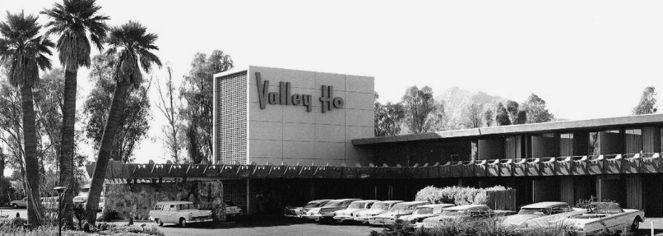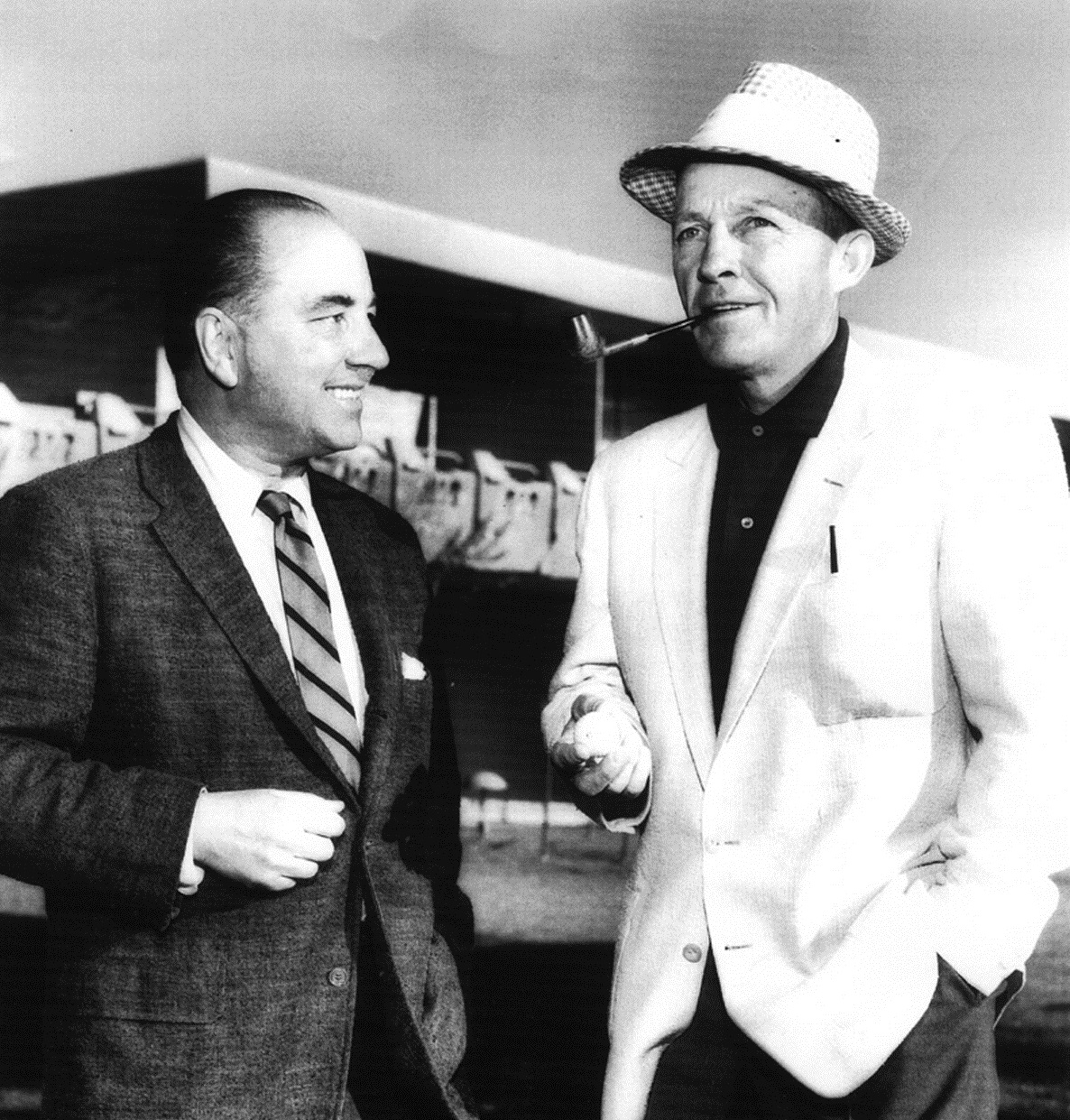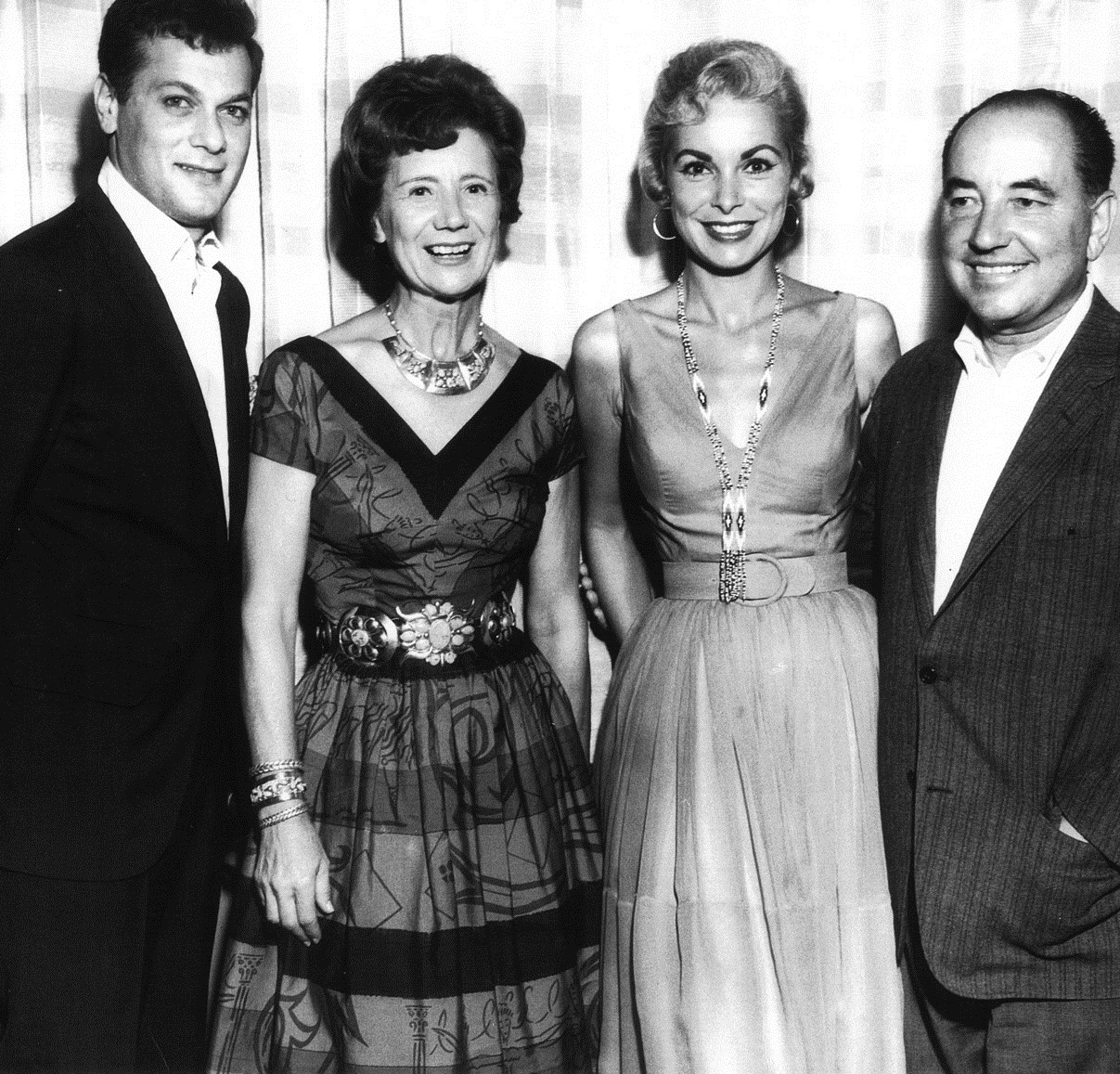Receive for Free - Discover & Explore eNewsletter monthly with advance notice of special offers, packages, and insider savings from 10% - 30% off Best Available Rates at selected hotels.
history
Discover the Hotel Valley Ho with its blend of Southwestern architecture and a European plan.
Hotel Valley Ho, a member of Historic Hotels of America since 2007, dates back to 1956.
VIEW TIMELINEA member of Historic Hotels of America since 2007, Hotel Valley Ho has stood as a cherished landmark in downtown Scottsdale for more than a half-a-century. This brilliant boutique hotel was founded by Robert and Evelyn Foehl, two accomplished veterans of the hospitality industry. Better known as “Bobby,” Robert Foehl had managed the Biltmore Hotel in Los Angeles earlier in his life. Evelyn, on the other hand, had supervised the Hacienda del Sol in neighboring Tucson, becoming one of the first women to earn a managerial role in the business. As the amount of winter tourists to their native Scottsdale increased during the mid-1950s, the Foehls decided to build a magnificent boutique hotel in the heart of town. To finance the project, the couple formed a business partnership with John B. Mills, who owned the Hotel Westward Ho in Phoenix. Together, they hired the renowned architect Edward L. Varney to spearhead its design. An acolyte of Frank Lloyd Wright, Varney was revered throughout the nation for his use of Mid-century Modern architecture. Varney configured the hotel’s layout around a central courtyard and pool, which he intended to serve as the hub for all social activity onsite. Furthermore, Varney developed a curving, concrete porte-cochere that opened out onto a brilliant lobby space, inspiring all with a sense of awe. The hotel was also the first hotel in Scottsdale to have central air-conditioning, and thus the first to be open year-round. It was also the first to employ southwestern architecture along a European plan in the region. Each guestroom featured a black-and-white television, too, as well as some kitchenettes.
Costing some $1.5 million to complete, the business debuted as the “Hotel Valley Ho” to much anticipation on December 20, 1956. The Foehls and John B. Mills had chosen the name “Hotel Valley Ho,” based on the winning entry from a contest that they had hosted during the construction work. The name itself drew homage to the neighboring Paradise Valley, as well as the hotel owned by Mills. And while the three co-owned the new Hotel Valley Ho, Bobby and Evelyn Foehl quickly became the public face of the enterprise. In a matter of months, the hotel was one of the most popular destinations in the entire American Southwest. The location was particularly attracted to Hollywood’s elite, many of whom knew the Foehls from Bobby’s time working in California. Among the first celebrities to stay at the Hotel Valley Ho were Natalie Wood and Robert Wagner, who held their wedding reception inside the building in 1957. Tony Curtis and his wife, Janet Leigh, also made the hotel their home while they filmed parts of Psycho nearby. Jimmy Durante even performed on the piano within the hotel’s stunning lounge on many occasions. Other stars to grace the Hotel Valley Ho with their presence included Clark Gable, Carey Grant, Bing Crosby, Humphrey Bogart, Bette Davis, Marylin Monroe, and Zsa Zsa Gabor. Many famous professional athletes visited frequently, too, especially after several Major League Baseball clubs relocated their Spring Training facilities to the region. As such, baseball icons like Bob Feller, Leo Durocher, and Ted Williams had all stayed inside the Hotel Valley Ho at one point or another.
Bobby Foehl passed away in 1973, prompting the remaining business partners to sell the building to Ramada. Renamed as the “Ramada Valley Ho,” the company covered much of the structure’s special architectural features in a vain attempt to maintain its appeal among modern travelers. Ramada expanded the building exponentially, as well, joining it onto another hotel that it had constructed in 1961. Nevertheless, interest in the building waned over the next three decades, forcing Ramada to abandon the endeavor in 2002. Some real estate developers had even intended to demolish the historic structure, but the intervention of architect Alan Hess managed to save it from the wrecking ball. In fact, concerned citizens had convinced the City of Scottsdale to list the building on the Scottsdale Historical Register. Around the same time, Ramada had opted to transfer ownership rights over to a local firm called “MSR Properties,” which planned completely restore the building back to its former glory. Construction immediately began in 2005, and cost close to $80 million! The spaces affiliated with the Ramada period were removed, while the original guestrooms and public venues received much needed care. In the end, the historical features concealed by Ramada were uncovered for all to appreciate once again. The new owners also installed wonderful new facilities like ZuZu, the OH Pool, VH Spa, and The Tower, too. Today, the reborn Hotel Valley Ho has resumed its historic status as one of the finest vacation hotspots in all of Arizona.
-
About the Location +
Hotel Valley Ho resides near the historic core of downtown Scottsdale, Arizona. Mere moments away from the state’s capital of Phoenix, Scottsdale itself is among the most celebrated holiday destinations in the region. But before its transformation into a vibrant resort community, the city once acted as the home to various Native America tribes for millennia. At first, the Hohokam occupied the area, constructing some 250 miles of canals and irrigation ditches that were unsurpassed in their engineering brilliance. But the Hohokam disappeared shortly before the arrival of Christopher Columbus, and two new native peoples—the Pima and the Papago—appeared in their stead. While the size of the community shrunk over the next several centuries, the Pima still continued to live in the area. Today, the nucleus of that settlement is now the Salt River Pima-Maricopa Indian Community, which is located on the periphery of Scottsdale. Eventually, a U.S. Army chaplain named Winfield Scott—not to be confused with the famous military leader—visited the area with his wife, Helen, in 1888. They both decided to purchase some 640 acres of land in order to establish a ranch. Winfield’s brother, George Washington Scott, soon joined the couple upon their request, and together, the trio founded a small village within the heart of the land grant. Acting as the town’s first residents, the Scotts quickly convinced dozens of people from across the Northeast and Midwest to relocate to the nascent farming community. Led by Rhode Island banker Albert G. Utley, the new inhabitants took to calling the town “Orangedale” after the large citrus trees that the Scotts had planted throughout the area.
Orangedale soon became “Scottsdale” in 1894, as the town began to expand rapidly. Since most of Scottsdale’s first generation of settlers were well-educated and possessed an appreciation for the arts, they invested heavily into developing the town’s emerging cultural identity. They helped finance the creation of a sophisticated public school system in 1896, and facilitated the creation of a thriving public square. The citizens also cultivated the growth of a vibrant artists’ colony, which grew to become one of Arizona’s largest by the dawn of the 20th century. Businesses soon opened in the center of town, as well, starting with J.L Davis’ general store in 1897. Several more prominent industries followed suit, including the famed Cavalliere’s Blacksmith Shop. Construction on the Granite Reef Dam and the Roosevelt Dam provided many with steady work, too, leading to a population boom that lasted for several years. Still, agriculture remained the major industry throughout much of the era, with cotton serving as the primary export. In fact, the U.S. Department of Agriculture supported most of the local cotton farms during World War I. Ranches also became a common sight in the area, as many civic leaders funded ranching operations all over town. But Scottsdale’s fantastic climate attracted more than just farmers—all kinds of aspiring hoteliers began establishing resorts and hotels, too. Beginning with the Ingleside Inn and the Jokake Inn, Scottsdale soon possessed a thriving hospitality industry that entertained guests from the neighboring communities of Tempe, Glendale, and Phoenix.
Scottsdale’s electric atmosphere endured for years after its founding, even as calamities like economic depression and global conflict spread across the world. The town’s enchanting community of artists grew in size, attracting many creative minds from all over the nation. The most noteworthy person to join the colony at the time was the renowned Frank Lloyd Wright, who purchased 600 acres of land just beyond the town limits for the creation of a seasonal home. Called “Taliesin West,” the residency doubled as both Wright’s vacation getaway and the southeastern headquarters for his esteemed architectural firm. The Thunderbird II Airfield also debuted in 1942, which trained over 5,500 pilot cadets to serve in the various theaters of World War II. Scottsdale kept expanding after the war, eventually becoming a formal city in 1951. A number of new industries also appeared at the middle of the century, such as Motorola, which opened a massive factory along McDowell Road in 1957. By the late 1960s, Scottsdale had truly started to resemble a typical modern American city. Nevertheless, the people of Scottsdale never lost sight of the community’s humble origins, celebrating its character as “The West’s Most Western Town.” Scottsdale today is still immensely proud of its heritage, as it continues to rate as one of Arizona’s most fascinating communities. It is also close to a number of fantastic cultural attractions, as well, such as the Desert Botanical Garden, the Arizona Capitol Museum, and Frank Llyod Wright’s Taliesin West. The picturesque Tonto National Forest and the Sonoran Desert National Monument are just a short drive away, too!
-
About the Architecture +
Originally built in 1956, the Hotel Valley Ho was first designed by the renowned architect Edward L. Varney. Varney himself was an accomplished practitioner of Mid-century Modern architecture, having studied under the renowned Frank Lloyd Wright during his youth. The accomplished Varney had designed many celebrated structures throughout his lifetime, such as much of the Tempe campus for Arizona State University, as well as complexes for the likes of Motorola, Sperry Rand, and General Electric. An offshoot of the earlier International and Bauhaus movements, Mid-century Modern itself sought to portray a seemingly contemporary, futuristic aesthetic that reflected the popular concepts of civil progress. Professional architects mainly utilized the style from the 1930s to the 1960s, when American society was rapidly undergoing huge transformations—both social and technological in nature. Architects thus embraced the design ideals of function, simplicity, and rationality in order to create sleek-looking structures that possessed a communal purpose. As such, Mid-century Modern designs made explicit use of vertical, flat lines and irregular rectangular shapes that conveyed a lack of formality. Overt ornamentation was abandoned, too, as monochromatic brickwork, steel, and concreate served as the essential building blocks for the exterior. Inside, most of the rooms were subdivided into split levels, giving a sense that the structure had undergone as significant change in elevation. Modernist buildings also featured wide, open spaces filled with natural light that represented practicality and comfort. Large widows often functioned as the primary way in which the architects achieved such a feature. Most of the rooms were also subdivided into split levels, giving a sense that the structure had undergone as significant change in elevation. The introduction of spacious windows even sought to better incorporate nature into the design, making the surrounding landscape seem as if it were part of the building itself.
-
Famous Historic Guests +
Bette Davis, actress known for her roles in All About Eve, Jezebel, and What Ever Happened to Baby Jane?
Betty Grable, actress known for her roles in such films like Mother Wore Tights and How to Marry a Millionaire.
Bob Feller, Hall of Fame pitcher for the Cleveland Indians.
Bing Crosby, singer and actor known for his roles in Going My Way and The Bells of St. Mary’s.
Cary Grant, actor known for such roles in To Catch a Thief, Charade, and North by Northwest.
Clark Gable, actor known for his roles in It Happened One Night, Mutiny on the Bounty, Gone with the Wind.
Frankie Avalon, actor and singer known for such singles as “Venus” and “Why.”
Humphrey Bogart, actor known for his roles in movies like Casablanca, The Maltese Falcon, and The Big Sheep.
Ingrid Bergman, actress known for her roles in such films like Gaslight, Notorious, and Casablanca.
James Cagney, actor known for his roles in such films like The Public Enemy, Angels with Dirty Faces, and The Roaring Twenties.
Janet Leigh, actress known for her roles in such films like Psycho, The Touch of Evil, and The Manchurian Candidate.
Jimmy Durante, comedian known for his roles in The Great Rupert and It Happened in Brooklyn.
Leo Durocher, Hall of Fame shortstop and manager for several baseball clubs, including the Brooklyn Dodgers and the New York Giants.
Marylin Monroe, actress known for her roles in Bus Stop and Some Like It Hot.
Natalie Wood, actress known for her roles in Rebel Without a Cause, Splendor in the Grass, and West Side Story.
Robert Wagner, actor known for his roles in such television shows like It Takes a Thief, Switch, and Hart to Hart.
Roy Rogers, actor best remembered for his role on The Roy Rogers Show.
Rudy Vallee, singer and actor known for his popular radio programs and comedic performance in such films like The Palm Beach Story.
Ted Williams, Hall of Fame outfielder for the Boston Red Sox, who is regarded as one of the best baseball players ever.
Tony Curtis, actor known for his roles in such films like Spartacus, The Defiant Ones, and Some Like It Hot.
Zsa Zsa Gabor, actress known for her roles in such films like Moulin Rouge¸ Lili, and We’re Not Married!



































